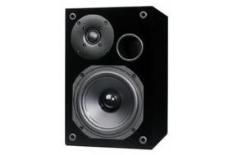NB - Product now replaced by 9.1 model; to be reviewed
No matter the hi-fi industry might wish it wasn't so, it's increasingly obvious that many people use their computer's hard disk as their primary source of music.
Even committed stereophiles of long standing are to be found firing up the Mac or PC when it's time to play some tunes. Unlike many competitors, AVI recognises and embraces this trend.
It's ready for digital sound
A glance at AVI's website (at times a tirade against pretty much everything and everyone involved in music reproduction until now) might convince you the ADM9s are groundbreaking – they're not.
We've been here before – most recently with Meridian's DSP6000s – but never before with such purpose and focus. AVI's identified consumers who didn't exist in big numbers until recently, and has tailored a product just for them.
The ADM9s are a front-ported design, and incorporate amplification and digital-to-analogue conversion. The left-hand speaker includes one stereo RCA input, outputs for left- and right-channel subwoofers and a single RCA output to the right-hand speaker.
Speakers must be powered
It also houses an IR sensor to allow remote control of volume levels and, in the case of our review sample, there's a digital optical TosLink input (the ADM9s can be specified with a USB input instead, see panel below). Both speakers must be plugged into the mains.
The ADM9s' talents are obvious pretty much from the get-go. Using one of our favourite CD players, Primare's £1500 CD31, the AVIs make perfect sense.
Connected first via the stereo RCA input, and therefore using the Primare's D-to-A processing, the AVIs offer a fast, detailed and thoroughly composed sound. There's punch and speed to low frequencies (though they're on the lean side), poised and expressive vocals in the midrange, and confident (occasionally over confident) treble reproduction.
Soundstaging and focus are impressive, too. Switching to the AVIs' own Wolfson DAC by connecting the Primare via its optical output offers still greater attack, dynamic headroom and resolution of transients – the ADM9s sound better doing their own conversion.
Great computer companions
It is possible to build great-sounding systems using only a pair of these traditional-looking ADM9s and a source such as a Sonos music server or a satellite TV box.
While we'd trade a little of the top-end clamour for a touch more body at the bottom end, these AVIs are a well-made, well-thought-out solution to a problem that's only going to become significantely more widespread.
If you've reconciled yourself to a future of computer-borne music, spend £1000 on these and forget separate amplifiers ever existed.

